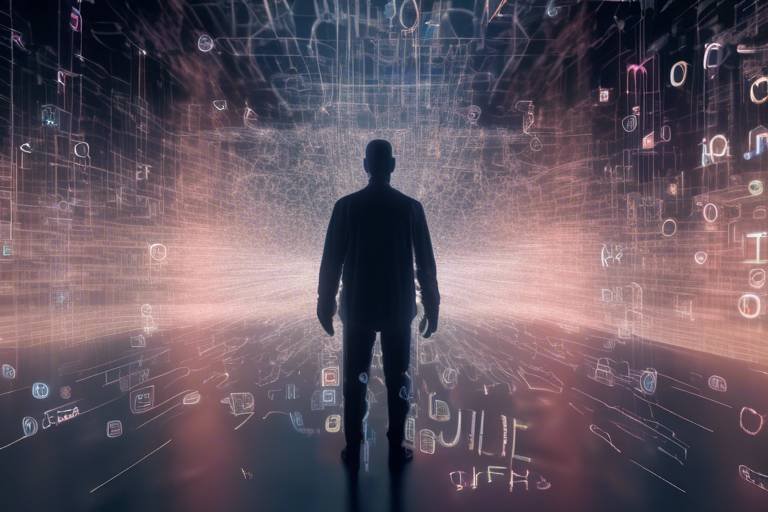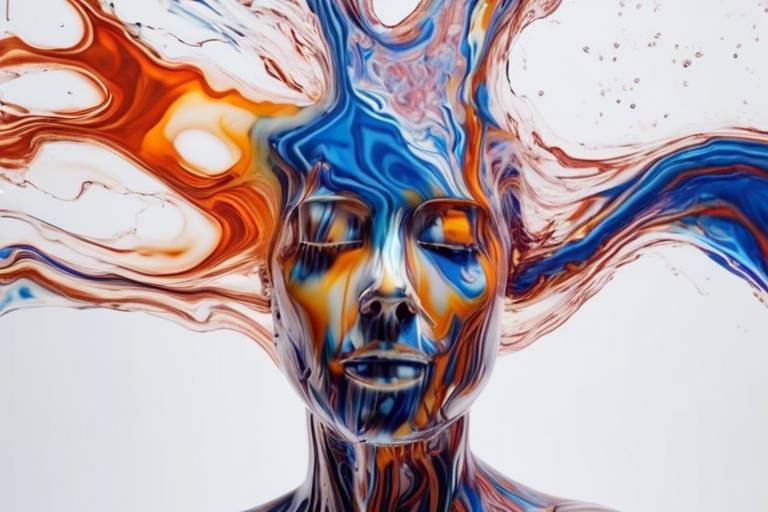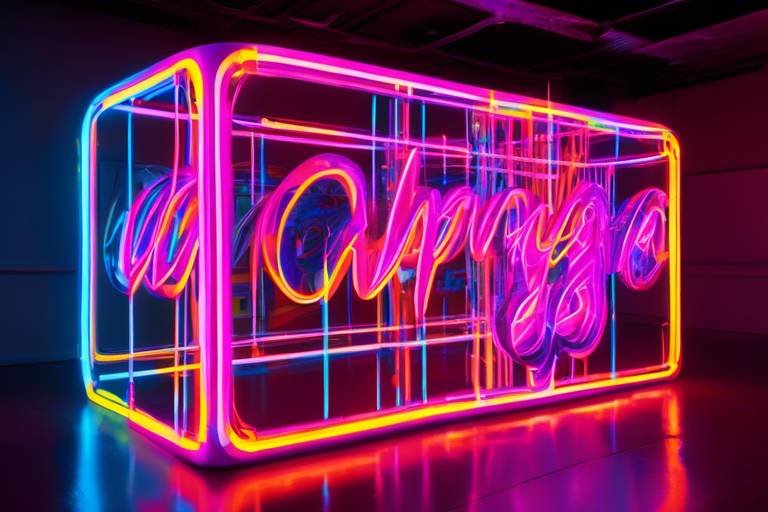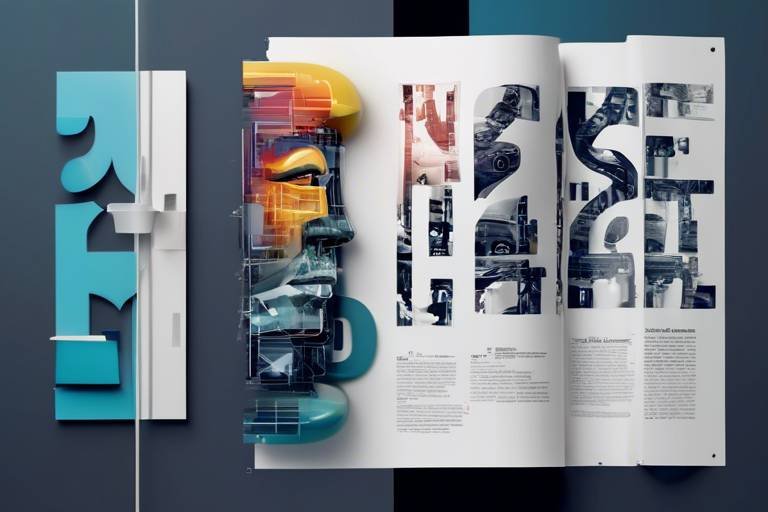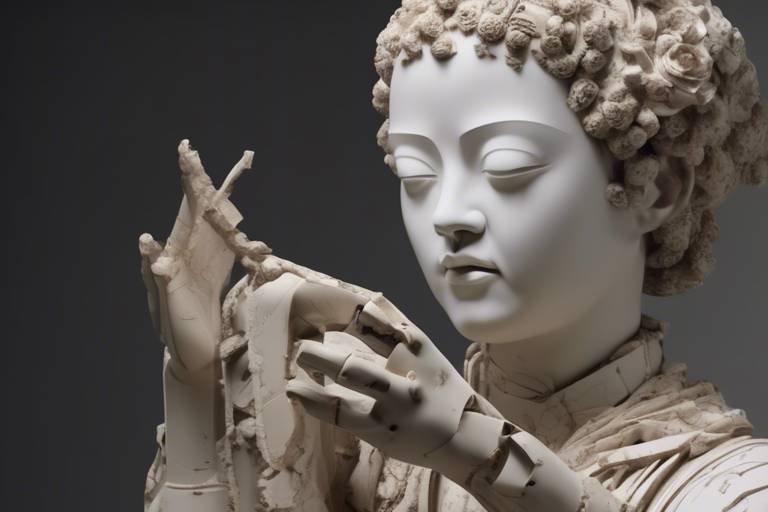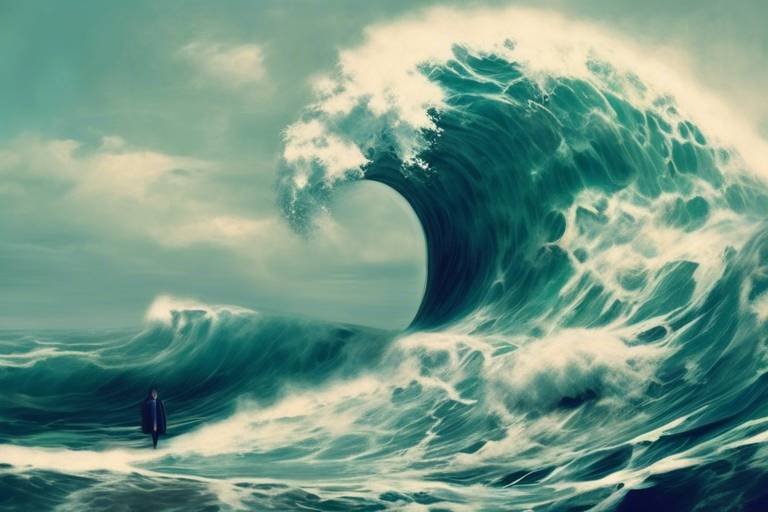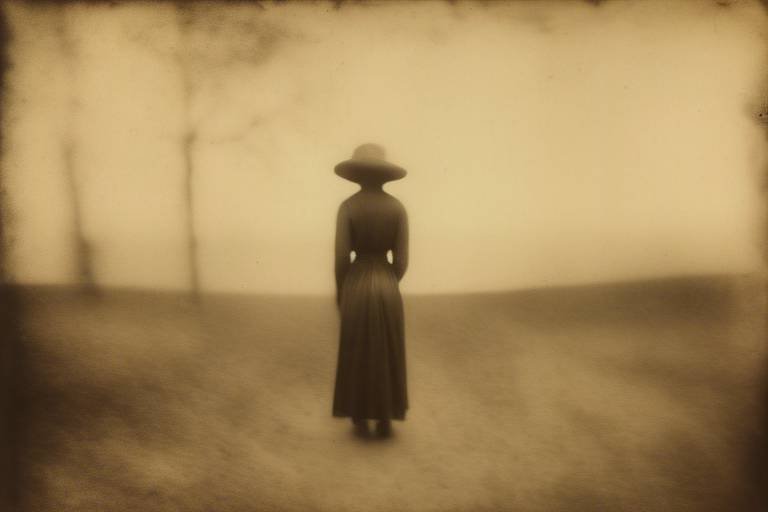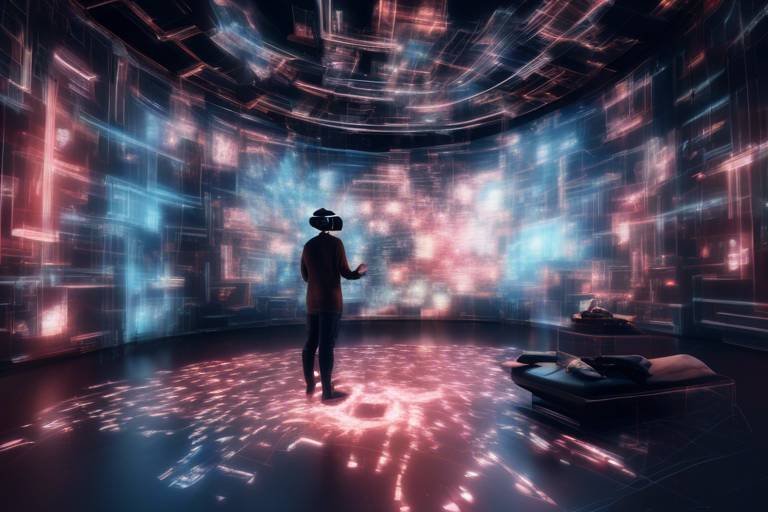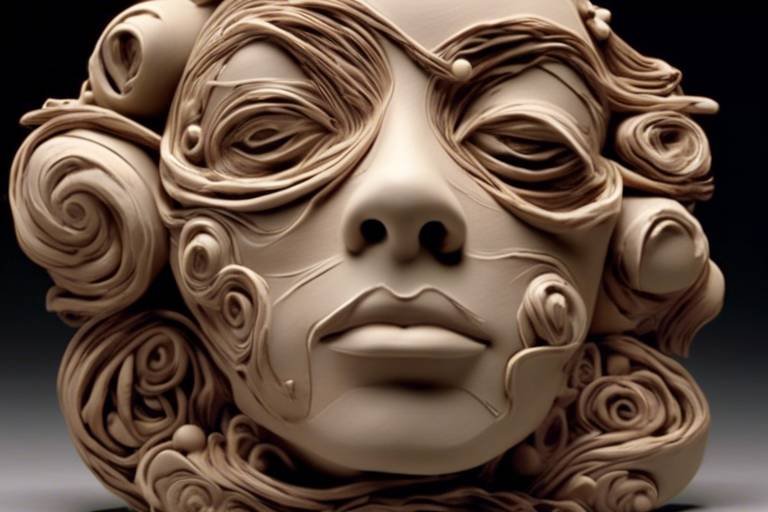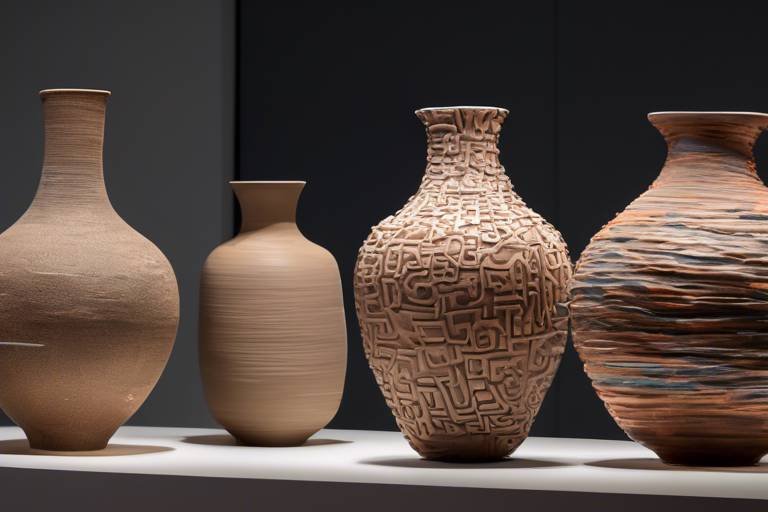How AI is Shaping New Forms of Art
The intersection of art and technology has always been a fertile ground for innovation, but the advent of artificial intelligence (AI) is taking this relationship to unprecedented levels. Imagine a world where machines not only assist artists but also create original pieces that challenge our understanding of creativity. This is not just a futuristic dream; it's happening right now. AI is reshaping the art landscape, providing artists with new tools that expand their creative horizons while also raising questions about authorship and originality. In this article, we will explore how AI is transforming the art world, the collaborations between artists and machines, and what the future holds for this exciting fusion.
AI-generated art is revolutionizing the creative landscape, offering new tools for artists and challenging traditional notions of authorship and creativity. The journey of AI in art began in the late 20th century, with early experiments in algorithmic art. Fast forward to today, and we see sophisticated AI systems capable of generating stunning visual art, music, and even literature. These systems analyze vast datasets, learning patterns and styles to create unique pieces that can evoke emotion and provoke thought.
One of the most fascinating aspects of AI art is its ability to democratize creativity. Artists who may not have technical skills in painting or digital design can now use AI tools to express their ideas. This shift is akin to how the invention of the camera opened new avenues for visual storytelling. Just as photographers became artists in their own right, so too are AI users finding their place in the art world.
Artists are increasingly collaborating with AI to create unique works that blend human creativity with machine learning. These partnerships can lead to surprising outcomes, where the artist's vision combines with the machine's analytical prowess to produce art that neither could achieve alone. It's a thrilling dance of creativity that pushes the boundaries of what art can be.
Consider the work of artists like Refik Anadol and Mario Klingemann. They have embraced AI as a collaborator, using algorithms to generate mesmerizing installations that captivate audiences. Their projects demonstrate that AI is not merely a tool but a co-creator in the artistic process, leading to a new form of expression that is both innovative and thought-provoking.
Exploring specific examples of artists who have successfully integrated AI into their creative processes highlights the diversity of artistic expression enabled by technology. For instance, Refik Anadol's “Archive Dreaming” project utilized AI to create immersive installations that visualize data in stunning ways. By feeding the AI vast amounts of data, he was able to produce art that reflects the collective memory of society.
Another notable example is Mario Klingemann, who uses neural networks to create portraits that challenge our perceptions of identity and beauty. His work prompts viewers to question the nature of art and the role of the artist in a world where machines can generate images that are both beautiful and unsettling.
Neural networks play a crucial role in AI art creation, allowing machines to learn from vast datasets. These networks mimic the human brain's interconnected neuron structure, processing information in complex ways. By analyzing patterns in existing art, neural networks can generate new pieces that reflect those styles while introducing novel elements. This technology not only enhances the creative process but also raises questions about the implications of machine-generated art.
The rise of AI in art raises important ethical questions regarding ownership, originality, and the role of the artist. Who owns the rights to a piece created by an AI? Is it the programmer, the artist, or the machine itself? These complexities challenge traditional notions of authorship and copyright, prompting a reevaluation of how we define art. As AI continues to evolve, artists and legal experts must grapple with these issues to ensure a fair and equitable future for all creators.
AI's influence extends beyond digital art, impacting traditional mediums like painting and sculpture. Artists are integrating AI into established forms to push boundaries and redefine their practices. For example, painters are using AI algorithms to generate new compositions or color palettes, creating a dialogue between human intuition and machine logic.
This fusion of technology and traditional art forms breathes new life into age-old practices, allowing artists to experiment and innovate in ways previously unimaginable. The result is a rich tapestry of artistic expression that reflects our contemporary digital age.
As technology continues to evolve, the future of AI in art holds exciting possibilities. We can expect to see more artists embracing AI as a collaborative partner, leading to new genres and movements that challenge our understanding of creativity. Imagine an art gallery where every piece is a collaboration between human and machine, each work telling a story that reflects the complexities of our modern world.
AI has the potential to inspire entirely new art movements, challenging existing paradigms. Just as the Impressionists broke away from traditional techniques, AI could lead to a revolution in how we perceive and create art. Emerging technologies could influence the direction of contemporary art, giving rise to styles and forms that we have yet to imagine.
The integration of AI into art education is transforming how artists learn and create. Educational programs are beginning to incorporate AI tools, teaching students to harness technology in their artistic endeavors. This shift not only equips future artists with essential skills but also encourages them to think critically about the role of technology in their work.
As we look to the future, it’s clear that AI will continue to shape the art world in profound ways. The collaboration between human creativity and machine intelligence is not just a trend; it’s a movement that will redefine our understanding of art for generations to come.
- What is AI-generated art? AI-generated art refers to artworks created with the assistance of artificial intelligence, often using algorithms and machine learning to produce unique pieces.
- Can AI replace human artists? While AI can create art, it lacks the emotional depth and personal experiences that human artists bring to their work. Instead, AI serves as a tool for collaboration.
- What are the ethical concerns surrounding AI in art? Key concerns include authorship, ownership, and the definition of creativity, as AI challenges traditional views on these issues.
- How is AI influencing traditional art forms? AI is being integrated into traditional mediums, allowing artists to experiment with new techniques and push the boundaries of their practices.

The Rise of AI-Generated Art
AI-generated art is revolutionizing the creative landscape, offering artists unprecedented tools to explore their imagination. Imagine a world where a machine can create stunning visuals, compose music, or even write poetry. Sounds like science fiction, right? But it’s happening now! The journey of AI in art began with simple algorithms and has evolved into complex systems capable of producing intricate works that challenge our traditional notions of authorship and creativity.
Initially, the concept of machines creating art was met with skepticism. Critics wondered, "Can a computer really understand beauty?" However, as technology advanced, artists began to embrace AI as a collaborator rather than a competitor. The evolution of AI art can be traced back to the early experiments in computer-generated graphics in the 1960s. Fast forward to today, and we have sophisticated neural networks that can analyze vast amounts of data to create original pieces of art.
One of the most intriguing aspects of AI-generated art is the way it democratizes creativity. With tools like DeepArt and Artbreeder, anyone can experiment with creating art without needing extensive training. These platforms allow users to input their ideas and let the AI do the heavy lifting, producing unique artworks that often blend styles and concepts in ways that humans might not even envision. It’s like having a creative partner who never tires and can draw from an endless well of inspiration.
Moreover, the rise of AI-generated art has sparked a new conversation about what it means to be an artist. Questions arise about originality and ownership: if a machine creates a piece, who owns it? Is it the programmer, the artist, or the machine itself? These discussions push us to rethink the very fabric of our artistic values. For instance, a recent auction saw an AI-generated painting sell for over $432,000, prompting debates on the authenticity and value of machine-made art.
As we continue to explore the intersection of technology and creativity, it’s clear that AI is not just a tool; it’s a catalyst for change. It challenges artists to expand their horizons and engage with new mediums and methods. The potential for collaboration between human creativity and artificial intelligence is vast, and as we embrace this new era, we are likely to witness an explosion of artistic expression that we can only begin to imagine.
In summary, the rise of AI-generated art is reshaping the art world in profound ways. It invites us to reconsider our understanding of creativity and encourages a collaborative spirit between humans and machines. As we venture further into this uncharted territory, one thing is certain: the art landscape will never be the same.

Collaborations Between Artists and AI
In today's dynamic art landscape, the collaboration between artists and artificial intelligence has become a thrilling frontier, blending human intuition with machine precision. Imagine a world where creativity knows no bounds—where a painter can harness the computational power of AI to explore uncharted territories of artistic expression. This partnership is not just a fleeting trend; it’s a profound transformation that is reshaping how art is created, perceived, and valued.
The beauty of these collaborations lies in their diversity. Artists are experimenting with various AI tools, from generative algorithms that create stunning visuals to neural networks that can analyze and learn from existing artworks. This fusion of technology and creativity is akin to a dance where both partners bring their unique strengths to the floor. For instance, an artist might use AI to generate a series of abstract patterns, which they then refine and personalize, resulting in a piece that is both original and a testament to the power of collaboration.
One notable example is the collaboration between artist Refik Anadol and AI systems. Anadol’s work often involves data-driven art installations that utilize machine learning to transform vast datasets into mesmerizing visual experiences. His projects, such as "Archive Dreaming," showcase how AI can interpret and visualize data in ways that are not only aesthetically pleasing but also intellectually stimulating. Through this collaboration, Anadol challenges viewers to reconsider their relationship with data and technology, pushing the boundaries of what art can represent.
Moreover, the integration of AI into the artistic process allows for an unprecedented level of experimentation. Artists can quickly iterate on their ideas, exploring multiple variations in a fraction of the time it would take using traditional methods. This speed and flexibility can lead to unexpected outcomes, sparking new ideas and directions. For example, the AI-generated works of artists like Mario Klingemann have raised eyebrows and ignited conversations around the nature of creativity itself. Are these works truly original, or are they merely reflections of the data fed into the algorithms? This question is at the heart of the discourse surrounding AI art.
As we delve deeper into these collaborations, it’s essential to recognize the ethical implications that arise. The question of authorship becomes increasingly complex when machines are involved in the creative process. Who owns the rights to a piece created by an artist and an AI? Is it the artist, the programmer, or the machine itself? These questions are not just theoretical; they have real-world consequences for artists navigating this new terrain.
In conclusion, the collaborations between artists and AI are not merely about technology enhancing creativity; they represent a paradigm shift in how we understand art itself. As artists continue to embrace AI as a partner in their creative journeys, we can expect to see an explosion of innovative works that challenge our perceptions and redefine the very essence of artistic expression.
- What is AI-generated art? AI-generated art refers to artworks created with the assistance of artificial intelligence algorithms, which can analyze data and produce unique visual or auditory pieces.
- How do artists collaborate with AI? Artists collaborate with AI by using algorithms and machine learning tools to generate ideas, visuals, or even entire artworks, which they then refine or build upon.
- What are the ethical considerations of AI in art? Ethical considerations include questions of authorship, ownership, and the implications of using data that may not belong to the artist.
- Can AI replace human artists? While AI can assist in the creative process, it lacks the emotional depth and personal experiences that human artists bring to their work.

Case Studies of Successful Collaborations
In the ever-evolving landscape of art, the intersection of human creativity and artificial intelligence is producing some astonishing results. Several artists have embraced AI not just as a tool but as a collaborator, leading to groundbreaking works that challenge our understanding of creativity. One notable example is the collaboration between Refik Anadol and AI algorithms. Anadol, a media artist and director, utilizes machine learning to transform vast datasets into mesmerizing visual narratives. His project, “Infinity Room,” creates a space where viewers are immersed in a digital environment that continuously evolves based on real-time data inputs. This fusion of technology and art not only captivates audiences but also raises questions about the role of the artist in the creation process.
Another fascinating case is the partnership between Mario Klingemann and neural networks. Klingemann, known for his pioneering work in AI art, uses generative adversarial networks (GANs) to create stunning pieces that blur the lines between human and machine creativity. His piece, “Neural Glitch,” showcases the unpredictable beauty that emerges when an artist allows AI to influence their work. By training the AI on thousands of images, Klingemann allows it to generate new forms that he then curates, resulting in a unique dialogue between man and machine. This collaboration exemplifies how AI can enhance artistic expression rather than replace it.
Furthermore, the duo of Anna Ridler and AI algorithms has produced captivating results in the realm of storytelling. Ridler’s project, “Mosaic Virus,” uses AI to generate a visual narrative based on the themes of a traditional story. By feeding the AI with historical data and personal anecdotes, she creates a hybrid art form that combines elements of both digital and traditional storytelling. This innovative approach not only engages the audience but also invites them to reflect on the nature of narrative and memory in the digital age.
These case studies highlight a broader trend where artists are not merely using AI as a tool but are actively engaging in a collaborative process. As artists like Anadol, Klingemann, and Ridler demonstrate, the integration of AI into the creative process can lead to unexpected and profound artistic expressions. It's a partnership that opens new avenues for exploration, allowing artists to push the boundaries of their craft and redefine what art can be.
In addition to these individual collaborations, there are also emerging collectives and platforms that facilitate such partnerships. For instance, organizations like Obvious are dedicated to exploring the potential of AI in art. Their work, particularly with the AI-generated portrait “Edmond de Belamy,” which famously sold at auction for $432,500, underscores the growing acceptance and intrigue surrounding AI art. This sale not only sparked conversations about the value of AI-generated works but also highlighted the collaborative potential between human artists and AI technologies.
As we look to the future, it’s clear that these collaborations will continue to evolve, offering exciting possibilities for artistic expression. The synergy between human intuition and machine learning creates a rich tapestry of creativity that challenges our perceptions of authorship and originality. The art world is witnessing a transformation, and it’s thrilling to see how artists are embracing AI to create works that are not only visually stunning but also conceptually rich.
- What is AI-generated art? - AI-generated art refers to artwork created with the assistance of artificial intelligence algorithms, often involving machine learning techniques.
- How do artists collaborate with AI? - Artists collaborate with AI by using algorithms to generate ideas, images, or entire pieces, which they then refine and curate.
- Are AI-generated artworks considered original? - This is a complex question; while the AI creates the work, the artist's input and guidance play a crucial role in the final piece, leading to debates about originality and authorship.
- What are some ethical concerns surrounding AI in art? - Ethical concerns include issues of ownership, the potential for loss of traditional artistic skills, and the implications of using AI trained on existing artworks.

The Role of Neural Networks
Neural networks are at the heart of the AI art revolution, acting as the brain behind many creative algorithms that produce stunning visual works. But what exactly are neural networks? In simple terms, they are computational models inspired by the human brain, designed to recognize patterns and make decisions based on input data. These networks consist of interconnected layers of nodes, or "neurons," that process information and learn from it, much like how we learn from our experiences.
When it comes to art, neural networks are trained on vast datasets of existing artworks, allowing them to understand various styles, techniques, and color palettes. This training enables the AI to generate new images that mimic the characteristics of the input data. Imagine teaching a child to paint by showing them thousands of pictures; over time, they would begin to develop their own style based on what they've seen. Similarly, neural networks can create original pieces by blending learned styles and concepts.
There are several types of neural networks used in art creation, each with its unique capabilities:
- Convolutional Neural Networks (CNNs): These are particularly effective for image processing tasks, allowing AI to analyze and generate images with intricate details.
- Generative Adversarial Networks (GANs): This type involves two neural networks—the generator and the discriminator—working against each other to create realistic images. The generator creates images, while the discriminator evaluates them, leading to continuous improvements until the output is indistinguishable from real art.
- Recurrent Neural Networks (RNNs): While more commonly used in text and sequence data, RNNs can also contribute to art by generating sequences of images or animations.
The implications of using neural networks in artistic practices are profound. Artists can now explore possibilities that were previously unimaginable, experimenting with styles and techniques that merge human intuition with machine learning. As a result, the boundaries of creativity are continually expanding, allowing for a richer dialogue between human and machine. However, this also raises questions about the nature of creativity itself. Can a machine truly create art, or is it merely a reflection of the data it has been trained on? This ongoing debate fuels the exploration of what it means to be an artist in an age dominated by technology.
In conclusion, neural networks are not just tools but collaborators in the creative process. They challenge traditional notions of authorship and originality, pushing artists to rethink their roles and the essence of art itself. As we continue to embrace these technologies, the potential for innovation and transformation in the art world is limitless.
- What is a neural network? A neural network is a computational model that simulates the way human brains operate, allowing machines to learn from data and make decisions.
- How do neural networks create art? Neural networks analyze large datasets of existing artworks to learn styles and techniques, which they then use to generate new, original pieces of art.
- Are neural networks replacing human artists? No, neural networks are tools that assist artists in their creative processes, enabling new forms of expression rather than replacing human creativity.
- What are GANs? Generative Adversarial Networks are a type of neural network where two networks compete against each other to produce realistic images.

Ethical Considerations in AI Art
The integration of artificial intelligence into the art world is not without its ethical dilemmas. As AI-generated artworks proliferate, questions surrounding ownership, originality, and the very essence of creativity come to the forefront. Who owns the rights to a piece of art created by a machine? Is it the programmer who developed the algorithm, the artist who guided the AI, or the AI itself? These questions are increasingly relevant in a landscape where machines can produce stunning visuals that rival human creativity.
Moreover, the concept of originality is being challenged. Traditional art has always been rooted in the personal experiences and emotions of the artist. However, AI lacks personal experiences and emotions, raising the question: can a machine truly create art? The lines blur when we consider that AI can analyze and replicate styles from countless artists, leading to a potential dilution of individual artistic expression. This phenomenon can be likened to a chef who follows a recipe without ever tasting the dish; while the outcome might be technically perfect, it lacks the heart and soul that comes from personal experience.
Furthermore, the use of AI in art raises concerns about cultural appropriation. When AI is trained on datasets that include various cultural artworks, it can inadvertently reproduce styles and motifs without understanding their significance. This could lead to a scenario where cultural symbols are used without context or respect, effectively commodifying and trivializing them. Artists and technologists must tread carefully to ensure that the use of AI is respectful and mindful of the cultural origins of the art it generates.
To navigate these complex ethical waters, it is essential for artists, technologists, and policymakers to engage in open dialogues. Establishing guidelines and frameworks for the use of AI in art can help address these concerns. For instance, clear attribution protocols could be developed to ensure that both human and machine contributions are recognized. Additionally, educational initiatives could foster a deeper understanding of the implications of AI in creative fields, equipping artists with the tools to use AI responsibly.
As we continue to explore the intersection of art and technology, it becomes increasingly important to consider the ethical landscape surrounding AI-generated art. By fostering a culture of awareness and responsibility, we can ensure that the integration of AI into the art world enhances rather than undermines the rich tapestry of human creativity.
- What is AI-generated art? AI-generated art refers to artworks created with the assistance of artificial intelligence algorithms, which can analyze and produce visual content based on learned patterns.
- Who owns AI-generated art? Ownership can be a complex issue, often depending on the agreements between the artist, the programmer, and the AI's output. Legal frameworks are still evolving in this area.
- Can AI truly create art? While AI can produce visually stunning works, the debate continues about whether these creations can be considered "art" in the traditional sense, as they lack personal experience and emotional depth.
- How can artists use AI responsibly? Artists can use AI responsibly by understanding its capabilities and limitations, ensuring proper attribution, and being mindful of cultural contexts in their work.

Impact on Traditional Art Forms
The advent of artificial intelligence (AI) is not just a phenomenon confined to the realm of digital art; it is also making significant waves in traditional art forms. Imagine a painter standing in front of a canvas, brush in hand, but with a digital assistant that offers suggestions on color palettes, composition, or even themes based on historical data and current trends. This is not science fiction; it is the reality that many artists are embracing today. The integration of AI into traditional mediums like painting, sculpture, and even performance art is challenging the very essence of what it means to create.
One of the most fascinating aspects of AI's influence on traditional art forms is its ability to expand the artist's toolkit. For example, artists can now use AI algorithms to analyze their work, providing insights into their style and technique. This feedback loop allows artists to refine their skills and explore new directions they might not have considered otherwise. Furthermore, AI can assist in the creation of intricate designs that would be incredibly time-consuming to produce by hand. By automating these repetitive tasks, artists can focus more on the *creative* aspects of their work.
Moreover, AI is also redefining the collaborative process in traditional art. Artists are teaming up with AI systems to create hybrid works that blend human intuition with machine precision. This collaboration can lead to unexpected and innovative results, pushing the boundaries of what is traditionally accepted in art. For instance, a sculptor might use AI to generate a 3D model of a statue, which can then be brought to life using traditional sculpting techniques. The outcome is a piece that is both *technologically advanced* and steeped in traditional craftsmanship.
However, this integration is not without its challenges. Traditional artists often grapple with the question of authenticity and originality when AI is involved in the creative process. If a machine can generate a piece of art, who owns it? Is it the artist who guided the AI, or does the machine hold some claim to the work? These questions are not just theoretical; they have real implications for artists navigating this new landscape.
To illustrate the impact of AI on traditional art forms, consider the following table that summarizes some of the key ways AI is influencing various mediums:
| Art Form | AI Influence | Examples |
|---|---|---|
| Painting | Color analysis, style transfer | Artists using AI to suggest color schemes or replicate styles |
| Sculpture | 3D modeling, design assistance | Sculptors using AI-generated models as a base for their work |
| Performance Art | Interactive installations, choreography | Using AI to create responsive environments or movements |
As we move forward, the dialogue between AI and traditional art forms will likely continue to evolve. Artists who embrace this technology might find themselves at the forefront of a new artistic renaissance, where the lines between human creativity and machine intelligence blur. Ultimately, rather than replacing traditional methods, AI is enhancing them, offering artists new avenues for exploration and expression.
- How is AI changing traditional art forms?
AI provides new tools and techniques that artists can use to enhance their creative processes, allowing them to explore new styles and methods. - Are AI-generated artworks considered original?
This is a complex issue; while AI can create unique pieces, questions of authorship and originality remain hotly debated. - Can AI replace human artists?
AI can assist and enhance the creative process, but it cannot replicate the emotional depth and personal experience that human artists bring to their work.

The Future of AI in Art
The future of AI in art is not just a distant dream; it’s a rapidly approaching reality that promises to reshape how we create, experience, and understand art. Imagine a world where artists collaborate with intelligent machines, pushing the boundaries of creativity beyond what we can currently fathom. As technology continues to evolve at breakneck speed, the integration of AI into the art world opens up a treasure trove of possibilities that could redefine artistic expression.
One of the most exciting aspects of this evolution is the potential for new art movements. Just as the Impressionists and Surrealists transformed the art landscape in their time, AI could inspire a new wave of artistic innovation. With AI's ability to analyze vast amounts of data and generate unique visual styles, we may witness the emergence of art forms that blend human intuition with machine precision. Artists could leverage AI to explore uncharted territories, creating pieces that challenge our perceptions and evoke new emotions.
Furthermore, the educational landscape for aspiring artists is also set to undergo a significant transformation. Imagine classrooms where students not only learn traditional techniques but also master AI tools that enhance their creative processes. Educational programs are beginning to incorporate AI-driven software, allowing students to experiment with machine learning algorithms and digital creativity. This integration will equip future artists with a diverse skill set, preparing them for a world where technology and artistry coexist harmoniously.
As we look ahead, it’s crucial to consider the ethical implications of AI in art. Questions surrounding copyright, authorship, and the role of the artist will become increasingly complex. For instance, if an AI generates a breathtaking piece of art, who owns it? The artist who provided the initial input, the programmer who designed the AI, or the AI itself? These dilemmas will necessitate new frameworks and discussions within the art community, ensuring that the human touch remains at the forefront of artistic creation.
Moreover, AI's influence is not limited to digital art. Traditional art forms such as painting and sculpture are also being transformed. Artists are beginning to incorporate AI into their practices, using algorithms to generate patterns or even to assist in the physical creation of sculptures. This fusion of traditional techniques with cutting-edge technology could lead to a renaissance in how we perceive and interact with art.
In conclusion, the future of AI in art is filled with exciting possibilities. As we stand on the brink of this new era, it’s essential to embrace the changes while also reflecting on the values that define art. The collaboration between human creativity and artificial intelligence has the power to enrich our cultural landscape, offering us new ways to express ourselves and connect with one another. So, what does the future hold for artists and AI? Only time will tell, but one thing is for sure: the journey is going to be nothing short of extraordinary.
- How does AI influence traditional art forms? AI is being integrated into traditional mediums, allowing artists to explore new techniques and redefine their practices.
- What are the ethical concerns surrounding AI-generated art? Issues like authorship, ownership, and the role of the artist are becoming increasingly complex as AI plays a larger role in art creation.
- Will AI replace human artists? No, AI is seen as a tool that can enhance human creativity rather than replace it, fostering collaboration between artists and technology.
- How is AI being integrated into art education? Educational programs are incorporating AI tools, helping students learn how to use technology in their creative processes.

Potential for New Art Movements
As we stand on the brink of a technological revolution, the potential for new art movements fueled by artificial intelligence is not just a possibility; it's an impending reality. Imagine a world where the brushstrokes of a painter are informed by algorithms that analyze centuries of art history, or where a musician composes symphonies in collaboration with a neural network that learns from the greatest composers of all time. This is not science fiction; this is the future of art, and it's happening right now.
The integration of AI into the creative process is akin to the invention of the camera in the 19th century, which radically transformed how artists viewed and represented the world. Just as the camera gave rise to movements like Impressionism, AI is poised to inspire entirely new genres and styles that challenge our understanding of creativity and originality. Artists are beginning to explore the possibilities of generative art, where algorithms not only assist but also create independently, leading to experiences that are both novel and thought-provoking.
Furthermore, AI's ability to analyze vast amounts of data can uncover patterns and themes that human artists might overlook. By harnessing this capability, artists can create works that reflect the complexities of contemporary society, addressing issues such as climate change, social justice, and the human experience in the digital age. For instance, AI can help visualize data in ways that evoke emotional responses, turning statistics into compelling visual narratives that resonate with audiences.
As we delve deeper into this fusion of technology and art, we might witness the emergence of movements that blend traditional artistic practices with cutting-edge technology. For example, AI-assisted installations could become a staple in galleries, where viewers interact with art that evolves in real-time based on their engagement. This interactivity could redefine the role of the audience from passive observer to active participant, creating a dynamic relationship between the artwork and its viewers.
Moreover, the democratization of art creation through AI tools is likely to lead to a broader range of voices and perspectives in the art world. Artists from diverse backgrounds can leverage these technologies to express their unique experiences, potentially leading to movements that reflect a more global and inclusive narrative. Imagine a collective of artists from different cultures collaborating with AI to create a multi-faceted exhibition that transcends geographical boundaries and cultural barriers.
In summary, the potential for new art movements driven by AI is vast and exciting. As artists continue to experiment and push the boundaries of what is possible, we can expect a rich tapestry of innovation that not only redefines art but also challenges our perceptions of creativity itself. The future is bright, and it promises to be filled with unexpected surprises and explosive creativity that will leave an indelible mark on the art world.
- What is AI-generated art? AI-generated art refers to artwork created with the assistance of artificial intelligence technologies, often using algorithms and machine learning to produce unique pieces.
- How does AI influence traditional art forms? AI influences traditional art by providing new tools and methods for artists, allowing them to experiment and create in ways that were previously unimaginable.
- Are there ethical concerns surrounding AI in art? Yes, ethical concerns include questions of authorship, originality, and the potential for AI to replace human creativity.
- What are some examples of AI in art education? Educational programs are emerging that teach artists how to use AI tools, fostering a new generation of creatives who can blend technology with traditional artistic practices.

Education and AI in Art
As we delve into the realm of education and its intersection with artificial intelligence (AI) in art, it’s evident that we are standing at the brink of a revolutionary change. Imagine a classroom where traditional art techniques blend seamlessly with cutting-edge technology, creating a vibrant learning environment that fosters both creativity and technical skills. This is not a distant dream; it is a reality that many art schools and educational institutions are beginning to embrace. The integration of AI into art education is reshaping how artists learn, create, and interact with their craft.
One of the most exciting aspects of incorporating AI into art education is the ability to access and analyze vast amounts of data. Students can utilize AI tools to study historical art movements, analyze techniques used by masters, and even create their own unique styles by learning from the algorithms that drive AI-generated art. This combination of human creativity and machine intelligence opens up new avenues for exploration, allowing students to push the boundaries of what is possible in their artistic endeavors.
Furthermore, educational programs are increasingly offering workshops and courses specifically focused on AI in art. These programs often cover a range of topics, from the basics of machine learning to hands-on experience with AI art generation tools. Students are not just passive recipients of knowledge; they become active participants in a collaborative process that challenges their understanding of art and technology. For instance, platforms like Runway ML and DeepArt provide users with user-friendly interfaces to create stunning visuals, making it easier for budding artists to experiment and innovate.
In addition to technical skills, the integration of AI in art education encourages students to think critically about the implications of technology in their work. Questions about originality, authorship, and the role of the artist become central to discussions in the classroom. As students grapple with these complex issues, they develop a deeper understanding of their own artistic identities and the evolving landscape of the art world. This critical thinking is essential for preparing future artists to navigate a field that is increasingly influenced by technology.
To illustrate the current landscape of art education and AI, let’s take a look at some notable programs around the world:
| Institution | Program Focus | Key Features |
|---|---|---|
| Rhode Island School of Design | AI and Design | Interdisciplinary approach integrating AI tools in design projects. |
| California Institute of the Arts | Digital Media | Courses on AI art generation and interactive installations. |
| Goldsmiths, University of London | Creative Computing | Focus on combining art, technology, and computing. |
As we look to the future, it’s clear that the intersection of education and AI in art will continue to evolve. More institutions are likely to adopt AI-centric curricula, reflecting the growing importance of technology in creative fields. This shift not only prepares students for careers in art but also equips them with the skills needed to thrive in an increasingly digital world. The artists of tomorrow will be those who can seamlessly blend their creative instincts with technological advancements, creating works that resonate on multiple levels.
In conclusion, the integration of AI into art education is not just about teaching students how to use new tools; it's about fostering a mindset that embraces innovation, encourages collaboration, and challenges traditional notions of art. As educators and students alike navigate this exciting frontier, the future of art education looks brighter than ever, filled with endless possibilities for creativity and expression.
- What is AI-generated art? AI-generated art refers to artwork created with the assistance of artificial intelligence algorithms, often using machine learning techniques to analyze and produce visual content.
- How is AI being used in art education? AI is being used in art education to enhance learning experiences, allowing students to explore new creative techniques and understand the implications of technology in their work.
- Are there ethical concerns with AI in art? Yes, there are several ethical considerations, including issues of authorship, originality, and the potential for AI to replace human artists.
- What skills do artists need to learn about AI? Artists should focus on developing technical skills related to machine learning, data analysis, and an understanding of AI tools that can aid in the creative process.
Frequently Asked Questions
- What is AI-generated art?
AI-generated art refers to artworks created with the assistance of artificial intelligence. This can include anything from digital paintings to music and even poetry, where algorithms analyze data to produce creative outputs. It's like having a digital partner that helps artists push the boundaries of creativity!
- How does collaboration between artists and AI work?
Collaboration between artists and AI involves artists using AI tools to enhance their creative processes. For instance, an artist might input certain parameters into an AI program, which then generates unique visuals or sounds based on those inputs. It's a bit like having a brainstorming buddy that offers unexpected ideas!
- What role do neural networks play in AI art?
Neural networks are a key component of AI art as they allow machines to learn from large datasets. By analyzing patterns and styles from existing artworks, these networks can create new pieces that mimic or innovate upon traditional forms. Think of it as teaching a robot to paint by showing it thousands of masterpieces!
- Are there ethical concerns surrounding AI-generated art?
Absolutely! The rise of AI in art brings up important questions about ownership and originality. For example, if an AI creates a piece of art, who owns it? Is it the programmer, the artist, or the AI itself? These questions challenge our traditional views of authorship and creativity.
- How is AI impacting traditional art forms?
AI is influencing traditional art forms by providing artists with new tools and techniques to experiment with. For instance, painters might use AI to generate unique color palettes or compositions, while sculptors could utilize AI for designing intricate patterns. It's a fascinating blend of old and new!
- What does the future hold for AI in the art world?
The future of AI in art is brimming with possibilities! We might see the emergence of entirely new art movements inspired by AI technologies. Additionally, educational programs are likely to incorporate AI tools, helping the next generation of artists learn how to harness these technologies effectively.
- How can AI influence art education?
AI is transforming art education by introducing innovative tools that help students learn and create. For example, programs that teach students how to use AI software can prepare them for a future where technology and creativity go hand in hand. It's like giving them a digital toolbox for artistic exploration!



